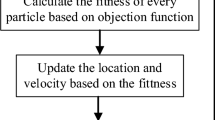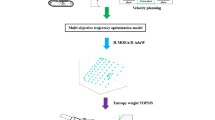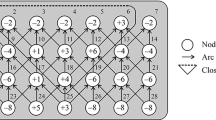Abstract
Large cable shovel (LCS) is a complex engineering machine which is widely used in the open pit mine. It is characterized by low efficiency, high maintenance cost, and high energy consumption if manipulated by an inexperienced operator. To address these challenges, intelligentization could be a feasible solution. In this work, an intelligent excavation system is put forward and the corresponding energy-minimum optimization through trajectory planning of the optimal excavation is developed to realize the intelligentization of the LCS. Firstly, the excavating resistance acting on the dipper is modeled and the corresponding forces are analyzed. Then, by establishing the kinetics and dynamic models of the excavating process, the point to point (PTP) trajectory planning method is developed by setting the objective to minimize the energy consumption per unite volume material. Polynomial curves in different degrees are used in the PTP planning method and the optimal one is compared with the conventional S-curve in terms of the excavating performance. To explore the advantage of the proposed intelligent system and the corresponding trajectory planning based energy-minimum optimization method, four types of ore piles with different pile angles are compared with respect to the excavating performance. Results show that the larger the pile angle is, the later the maximum hoist power and crowd power will appear. Further, the effects on the excavating performance from different ore piles with complex terrains, including the flat type, concave type, convex type, and concave-convex type, are also studied in the numerical experiments. It is found that the trajectory based energy-minimum optimization method for the intelligent LCS can significantly save excavation energy as well as keep sufficient fill factor.























Similar content being viewed by others
References
Awuah-Offei K, Frimpong S (2006) Numerical simulation of cable shovel resistive forces in oil sands excavation. Int J Surf Min Reclam Environ 20(3):223–238
Awuah-Offei K, Frimpong S (2007) Cable shovel digging optimization for energy efficiency. Mech Mach Theory 42(8):995–1006
Awuah-Offei K, Frimpong S (2011) Efficient cable shovel excavation in surface mines. Geotech Geol Eng 29(1):19–26
Deb K, Pratap A, Agarwal S, Meyarivan T (2002) A fast and elitist multiobjective genetic algorithm: Nsga-ii. IEEE Trans Evol Comput 6(2):182–197
Denman A, McAree PR, Kearney M, Reid A, Austin KJ (2010) Swing trajectory control for large excavators. In: Field and service robotics. Springer, pp 401–410
Dexter A, CzyŻ E, Gaţe O (2007) A method for prediction of soil penetration resistance. Soil Tillage Res 93(2):412–419
Dong SK, Lee J (2015) Structural design of a level-luffing crane through trajectory optimization and strength-based size optimization. Struct Multidiscip Optim 51(2):515–531
Du J, Huang Z, Yang R (2015) Optimization of the motion control mechanism of the hatch door of airliner. Struct Multidiscip Optim 51(5):1173–1186
Dufour R, de Muelenaere J, Elham A (2015) Trajectory driven multidisciplinary design optimization of a sub-orbital spaceplane using non-stationary gaussian process. Struct Multidiscip Optim 52(4):755–771
Dunbabin M, Corke P (2006) Autonomous excavation using a rope shovel. J Field Rob 23(6-7):379–394
Frimpong S, Hu Y (2008) Intelligent cable shovel excavation modeling and simulation. Int J Geomech 8 (1):2–10
Frimpong S, Hu Y, Awuah-Offei K (2005) Mechanics of cable shovel-formation interactions in surface mining excavations. J Terrramech 42(1):15–33
Fung RF, Cheng YH (2014) Trajectory planning based on minimum absolute input energy for an lcd glass-handling robot. Appl Math Model 38(11):2837–2847
Guzzella L, Sciarretta A et al. (2007) Vehicle propulsion systems, vol 1. Springer, Berlin
Hsu YL, Huang MS, Fung RF (2014) Energy-saving trajectory planning for a toggle mechanism driven by a pmsm. Mechatronics 24(1):23–31
Hua HY, Lin SW, Shen ZH (2012) A new method of the constraints expression and handling for excavator boom structural optimization. In: Advanced materials research, trans tech publ, vol 479, pp 1851–1856
Huang MS, Hsu YL, Fung RF (2012) Minimum-energy point-to-point trajectory planning for a motor-toggle servomechanism. IEEE/ASME Trans Mechatron 17(2):337–344
McKyes E (1985) Soil cutting and tillage, vol 7. Elsevier, Amsterdam
Özgen C, Íder K, Söylemez E (2008) Shape optimization of an excavator boom by using genetic algorithm. PhD thesis, Middle East Technical University
Patel BP, Prajapati JM (2013) Structural optimization of mini hydraulic backhoe excavator attachment using fea approach. Mach Des 5(1):1821–1259
Patnayak S, Tannant D, Parsons I, Del Valle V, Wong J (2008) Operator and dipper tooth influence on electric shovel performance during oil sands mining. Int J Min Reclam Environ 22(2):120–145
Rasuli A, Tafazoli S, Dunford WG (2014) Dynamic modeling, parameter identification, and payload estimation of mining cable shovels. In: Industry applications society annual meeting, 2014 IEEE. IEEE, pp 1–9
Stavropoulou M, Xiroudakis G, Exadaktylos G (2013) Analytical model for estimation of digging forces and specific energy of cable shovel. Coupled Systems Mechanics 2(1):23–51
Sui TZ, Wang L, Tan Z, Jia PC (2012) Structural parameters optimization of excavator working device based on mining process. In: Advanced materials research, trans tech publ, vol 421, pp 759–763
Takahashi H, Hasegawa M, Nakano E (1998) Analysis on the resistive forces acting on the bucket of a load-haul-dump machine and a wheel loader in the scooping task. Adv Robot 13(2):97–114
Wei B, Gao F (2012) Digging trajectory optimization for a new excavating mechanism of electric mining shovel. In: ASME 2012 international design engineering technical conferences and computers and information in engineering conference. American Society of Mechanical Engineers, pp 1033–1039
Wei B, Gao F, Chen J, He J, Wu S, Song Q (2011) Mechanics performance of three-degree-of-freedom excavating mechanism of an electric shovel. Proc IME C J Mech Eng Sci 225(6):1443–1457
Wikipedia (2017) Generalised logistic function. Website. https://en.wikipedia.org/wiki/Generalised_logistic_function
Acknowledgements
The research is supported by National Natural Science Foundation of China (Grant No. U1608256 and 51505061).
Author information
Authors and Affiliations
Corresponding author
Additional information
Responsible Editor: Mehmet Polat Saka
Publisher’s Note
Springer Nature remains neutral with regard to jurisdictional claims in published maps and institutional affiliations.
Rights and permissions
About this article
Cite this article
Wang, X., Sun, W., Li, E. et al. Energy-minimum optimization of the intelligent excavating process for large cable shovel through trajectory planning. Struct Multidisc Optim 58, 2219–2237 (2018). https://doi.org/10.1007/s00158-018-2011-6
Received:
Revised:
Accepted:
Published:
Issue Date:
DOI: https://doi.org/10.1007/s00158-018-2011-6




